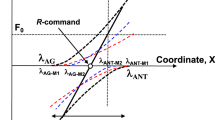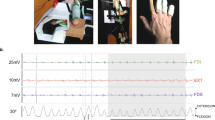Abstract
Electrical stimulation of the digital nerves can cause short- and long-latency increases in electromyographic activity (EMG) of the hand muscles, but mechanical stimulation of primarily tactile afferents in the digits generally evokes only a long-latency increase in EMG. To examine whether such stimuli can elicit short-latency reflex responses, we recorded EMG over the first dorsal interosseous muscle when subjects (n=13) used the tip of the right index finger to restrain a horizontally oriented plate from moving when very brisk tangential forces were applied in the distal direction. The plate was subjected to ramp-and-hold pulling loads at two intensities (a 1-N load applied at 32 N/s or a 2-N load applied at 64 N/s) at times unpredictable to the subjects (mean interval 2 s; trial duration 500 ms). The contact surface of the manipulandum was covered with rayon—a slippery material. For each load, EMG was averaged for 128 consecutive trials with reference to the ramp onset. In all subjects, an automatic increase in grip force was triggered by the loads applied at 32 N/s; the mean onset latency of the EMG response was 59.8±0.9 (mean ± SE) ms. In seven subjects (54%) this long-latency response was preceded by a weak short-latency excitation at 34.6±2.9 ms. With the loads applied at 64 N/s, the long-latency response occurred slightly earlier (58.9±1.7 ms) and, with one exception, all subjects generated a short-latency EMG response (34.9±1.3 ms). Despite the higher background grip force that subjects adopted during the stronger loads (4.9±0.3 N vs 2.5±0.2 N), the incidence of slips was higher—the manipulandum escaped from the grasp in 37±5% of trials with the 64 N/s ramps, but in only 18±4% with the 32-N/s ramps. The deformation of the fingertip caused by the tangential load, rather than incipient or overt slips, triggered the short-latency responses because such responses occurred even when the finger pad was fixed to the manipulandum with double-sided adhesive tape so that no slips occurred.




Similar content being viewed by others
References
Birznieks I, Jenmalm P, Goodwin AW, Johansson RS (2001) Encoding of direction of fingertip forces by human tactile afferents. J Neurosci 21:8222–8237
Chambers MR, Andres KH, Duering MV, Iggo A (1972) The structure and function of the slowly adapting type II mechanoreceptor in hairy skin. Q J Exp Physiol 57:417–445
Cole KJ, Abbs JH (1988) Grip force adjustments evoked by load force perturbations of a grasped object. J Neurophysiol 60:1513–1522
Edin BB, Howe R, Westling G, Cutkosky M (1993) A physiological method for relaying frictional information to a human teleoperator. IEEE Trans Syst Man Cybern 23:427–432
Evans AL, Harrison LM, Stephens JA (1989) Task-dependent changes in cutaneous reflexes recorded from various muscles controlling finger movement in man. J Physiol (Lond) 418:1–12
Häger-Ross C, Johansson RS (1996) Non-digital afferent input in reactive control of fingertip forces during precision grip. Exp Brain Res 110:131–141
Häger-Ross C, Cole K, Johansson RS (1996) Grip force responses to unanticipated object loading: load direction reveals body- and gravity-referenced intrinsic task variables. Exp Brain Res 110:142–150
Johansson RS (1978) Tactile sensibility in the human hand: receptive field characteristics of mechanoreceptive units in the glabrous skin area. J Physiol (Lond) 281:101–123
Johansson RS, Westling G (1984) Roles of glabrous skin receptors and sensorimotor memory in automatic control of precision grip when lifting rougher or more slippery objects. Exp Brain Res 56:550–564
Johansson RS, Westling G (1987) Signals in tactile afferents from the fingers eliciting adaptive motor responses during precision grip. Exp Brain Res 66:141–154
Johansson RS, Westling G (1988) Programmed and triggered actions to rapid load changes during precision grip. Exp Brain Res 71:72–86
Johansson RS, Riso R, Häger C, Bäckström L (1992a) Somatosensory control of precision grip during unpredictable pulling loads. I. Changes in load force amplitude. Exp Brain Res 89:181–191
Johansson RS, Häger C, Riso R (1992b) Somatosensory control of precision grip during unpredictable pulling loads. II. Changes in load force rate. Exp Brain Res 89:192–203
Johansson RS, Häger C, Bäckström L (1992c) Somatosensory control of precision grip during unpredictable pulling loads. III. Impairments during digital anesthesia. Exp Brain Res 89:204–213
Macefield VG, Johansson RS (1994) Electrical signs of cortical involvement in the automatic control of grip force. Neuroreport 5:2229–2232
Macefield VG, Johansson RS (1996) Control of grip force during restraint of an object held between finger and thumb: responses of muscle and joint afferents from the digits. Exp Brain Res 108:172–184
Macefield VG, Häger-Ross C, Johansson RS (1996a) Control of grip force during restraint of an object held between finger and thumb: responses of cutaneous afferents from the digits. Exp Brain Res 108:155–171
Macefield VG, Rothwell JC, Day BL (1996b) The contribution of transcortical pathways to long-latency stretch and tactile reflexes in human hand muscles. Exp Brain Res 108:172–184
McNulty PA, Macefield VG (2001) Modulation of ongoing EMG by different classes of low threshold mechanoreceptors in the human hand. J Physiol 537:1021–1032
McNulty PA, Turker KS, Macefield VG (1999) Evidence for strong synaptic coupling between single tactile afferents and motoneurones supplying the human hand. J Physiol 518:883–893
Phillips JR, Johnson KO (1981a) Tactile spatial resolution. II. Neural representation of bars, edges and gratings in monkey primary afferents. J Neurophysiol 46:1192–1203
Phillips JR, Johnson KO (1981b) Tactile spatial resolution. III. A continuum mechanics model of skin predicting mechanoreceptor responses to bars, edges and gratings. J Neurophysiol 46:1204–1225
Serrien DJ, Kaluzny P, Wicki U, Wiesendanger M (1999) Grip force adjustments induced by predictable load perturbations during a manipulative task. Exp Brain Res 124:100–106
Winstein CJ, Horak FB, Fisher BE (2000) Influence of central set on anticipatory and triggered grip-force adjustments. Exp Brain Res 130:298–308
Acknowledgements.
The authors gratefully acknowledge the technical expertise provided by Anders Bäckström. This work was supported by the Swedish Medical Research Council (project 08667). V.G. Macefield was a recipient of the Sunderland Award from the Ian Potter Foundation, Australia.
Author information
Authors and Affiliations
Corresponding author
Rights and permissions
About this article
Cite this article
Macefield, V.G., Johansson, R.S. Loads applied tangential to a fingertip during an object restraint task can trigger short-latency as well as long-latency EMG responses in hand muscles. Exp Brain Res 152, 143–149 (2003). https://doi.org/10.1007/s00221-003-1421-9
Received:
Accepted:
Published:
Issue Date:
DOI: https://doi.org/10.1007/s00221-003-1421-9




